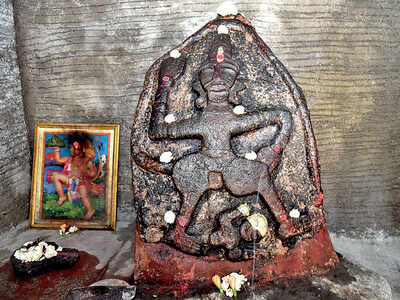Villagers restore idol that may date back 3 centuries

PIC: NIKHIL GHORPADE
For decades together now, residents of the small village of Khatpewadi in
Resistance was to be expected, and many locals greeted the idea with suspicion, deeming it to be an inauspicious move. The group soldiered on — and finally today, the idol stands restored, with five thick inches of shendur chipped away to reveal a clearly different version of the god killing a demon, his elongated tail creating a curve around the sculpture.

(Clockwise from top left) The deity before and after cleaning; the temple in which it is housed; the villagers involved in the initiative
While villagers have no record of how old the idol really is and when it was installed, archaeological experts that Mirror spoke to estimated that it may orginate from the 18th century, making it a formidable three centuries old.
Village resident Sharad Pawar, one of the project’s participants, told Mirror, “We villagers have no idea what time the idol dates back to or who made it. Our ancestors believed it to belonging it to the Pandav era (9 AD), but there is no written record.” Confirming that at least two generation of theirs have seen shendur applied to the deity, he shared that it was in 2017 that some of them became curious about what lies beneath. They decided to take the village into confidence to cleanse the idol. “Many of the senior residents in particular opposed this activity, believing that it questioned their faith. They claimed the act would bring bad omens. But a month ago, we decided to take it up anyway,” added Pawar.
Fellow villager Prakash Khatpe said a skilled individual was brought in to slowly remove layers of the shendur, starting from the base of the carving. “We began to see finer lines in the stone soon enough. By the end of it, at least 50 kg of shendur were scoured from the idol,” informed Khatpe, adding that the lowest layers were even decomposed and had ants dwelling inside them.
“We felt the idol — considered a living entity by villagers — was being suffocated. This cleaning breathed fresh life into it. A small Ganesh idol was also cleaned in a similar manner,” said Khatpe.
Yet another villager involved in this initiative, Pandurang Khatpe, said, “We had never seen the true shape or form of the idol. The temple has also never been developed with modern building materials. Its main structure has remained of the same size for years. We wish to preserve the temple and its deity in their most original conditions. Now, it has been decided collectively to not smother the idol in future with any materials that would obscure its true image.”
When Mirror spoke to archaeologist GB Deglurkar, who specialises in historic and pre-historic idols, he explained, “This carving seems to belong to the 18th century. Hanuman idols were seen around the 10th century, but only as a depiction of instances from
Commenting on the use of vermilion on a religious idol, former deputy superintendent archaeologist with the Archaeological Survey of India (ASI), Manager Singh, said, “Shendur does not harm rock carvings. However, it definitely makes it very difficult to know the original shape or form of the same.”
FROM AROUND THE WEB
GALLERIES View more photos







































Recent Messages ()
Please rate before posting your Review
SIGN IN WITH
Refrain from posting comments that are obscene, defamatory or inflammatory, and do not indulge in personal attacks, name calling or inciting hatred against any community. Help us delete comments that do not follow these guidelines by marking them offensive. Let's work together to keep the conversation civil.